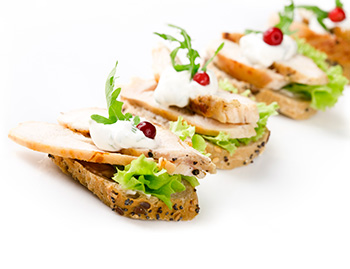As catering sales for both business and consumer-oriented social occasions continue to increase, restaurants and other foodservice operators keep finding they have more opportunity than ever to boost their drop-off and on-demand delivery services.
Technomic Talks: Catering
 During the past three years, sales of drop-off catering packages for both consumer social and business occasions increased 20 percent to a whopping $52.3 billion, according to Technomic. Sales for business catering has increased 7.2 percent per year since 2012, compared to 6 percent for consumer catering. Technomic attributes this growth to the lingering effects of the recent recession when the last study was conducted, and to convenience-seeking, socially-oriented Millennials who would rather order from their favorite restaurants than traditional caterers.
During the past three years, sales of drop-off catering packages for both consumer social and business occasions increased 20 percent to a whopping $52.3 billion, according to Technomic. Sales for business catering has increased 7.2 percent per year since 2012, compared to 6 percent for consumer catering. Technomic attributes this growth to the lingering effects of the recent recession when the last study was conducted, and to convenience-seeking, socially-oriented Millennials who would rather order from their favorite restaurants than traditional caterers.
On-Demand Delivery
More restaurants have been able to expand delivery services through an explosion of third-party companies like leaders GrubHub and Seamless and newcomers Door Dash, DeliverHero and Postmates, the latter of which uses drivers as well as messengers on foot and bike for making fast deliveries via an app for food and non-food needs. Pinkberry, FOCUS Brands and even Starbucks have partnered with Postmates to offer or test delivery in some markets.
Buffet Beauty
Trends in catering buffet setups continue to evolve, says Kathy Ruff, founder of Tablescapes, a Chicago-based, full-scale rental service supplying everything from unique pearl caviar spoons to tables and chairs to back-of-the-house equipment and supplies for caterers and chefs. “Customers are looking for homier, eclectic pieces that make the setting feel like a dinner party with their own signature style rather than just a banquet,” she says. “The trend is to have rental pieces that don’t look rented, so we always try to push the edge and look at things differently.”
In: Farmhouse chic, rustic elegance, mini serving vessels with petite silverware, mix-and-match plates, tables and chairs, wrought iron metal fixtures or bricks set over sterno to hold food
Out: Chafers and chafing dishes, big trays of casserole-like dishes
Quick Tips for Drop-Off
These step-by-step suggestions for restaurants and other foodservice operators looking to build or develop a drop-off catering program come from Jody Birnbaum, founder and president of Caterconsult, Inc., a Chicago-based consultancy providing catering and restaurant services for the foodservice industry.
- Do your research: Look at the competition and area demographics, survey current customers, and estimate costs and revenue to determine ROI.
- Consider operational and design adaptations: Evaluate the current space, and add equipment, prep tables, packaging, platters, disposable utensils and other supplies. Choose packaging carefully depending on the nature of the food and if it has to be reheated. Ventilated boxes maintain the crunch of toasted food like sandwiches and pizza; consider BPA-free plastic containers to maintain moisture in certain cooked foods.
- Determine delivery options: Reassign an existing vehicle or food truck for deliveries and don’t forget to call-out catering for extra branding, or research third-party, on-demand delivery services for drop-offs.
- Carefully construct the catering menu: Some items, like fried food, don’t travel well with or without the right packaging, so consider which items on the current menu work best for catering, and/or develop new catering-specific dishes.
- Train staff and promote and market the program: Establish standards for prepping and packaging catering orders, and use staff to talk about and upsell the catering program to customers, in addition to leveraging online, mobile apps and social media platforms.



